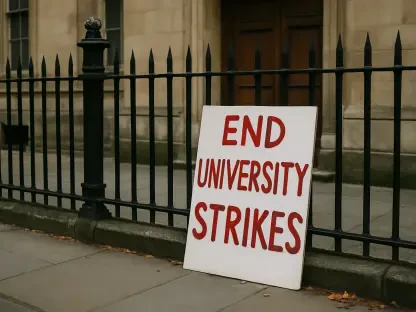Imagine a public university not just surviving but thriving amid the turbulent waters of higher education, where enrollment cliffs and funding cuts threaten even the most established institutions, and the University of Iowa has taken a bold step with the launch of Resparc (Revenue and Efficiencies Strategic Plan Action and Resource Committee), a comprehensive effort to secure long-term fiscal stability. This initiative, involving nearly 100 members from 35 university units, has sparked discussions across academia about proactive financial planning. This roundup gathers insights, opinions, and tips from various industry voices—administrators, financial analysts, and higher education policy experts—to explore how Resparc could redefine resilience in the sector. The purpose is to dissect diverse perspectives on this strategic move and assess its potential as a model for others facing similar challenges.
Diverse Views on Resparc’s Strategic Approach
A Bold Step or Bureaucratic Overreach?
Many in the higher education community view Resparc as a pioneering effort to address financial uncertainties before they become crises. Administrators from peer institutions have noted that the committee’s scale, with representation across multiple units, ensures a wide range of ideas for revenue generation and efficiency. They argue that this diversity could lead to innovative solutions, such as leveraging technology for operational savings or tapping into new philanthropy streams. The emphasis on foresight rather than reaction is seen as a refreshing departure from the typical cost-cutting seen elsewhere.
However, not all feedback is unequivocally positive. Some financial analysts express concern over the sheer size of the committee, suggesting that nearly 100 members might hinder swift decision-making. They caution that large groups often struggle with consensus, potentially delaying critical actions in a fast-changing environment. This perspective raises questions about whether a leaner task force might achieve similar goals with greater agility.
A third viewpoint comes from policy experts who see Resparc as a necessary experiment, despite its risks. They acknowledge the complexity of balancing diverse input with efficiency but argue that the initiative’s structure—split into specialized subcommittees focusing on areas like academics and financial operations—could mitigate these challenges. Their take is that the university’s willingness to test such a model offers valuable lessons for others, even if adjustments are needed along the way.
Financial Stability Versus Looming Threats
Industry observers highlight the University of Iowa’s current financial health as a strong foundation for Resparc’s ambitions, pointing to a 2.4% enrollment increase to 32,199 students and a $36.8 million operating income in the latest fiscal data. Many university leaders from other states commend this position, suggesting that acting from a place of strength allows for more creative risk-taking. They argue that this stability provides a buffer to explore long-term strategies without the immediate pressure of deficits.
Contrasting opinions emerge from analysts focused on broader trends, who warn that external pressures could undermine even this solid base. They reference challenges like a projected 4% decline in Iowa’s high school graduates over the next decade and a significant 15.7% rise in operating expenses, reaching $5 billion recently. These voices stress that while the university’s numbers look promising now, ignoring such headwinds could be shortsighted, urging Resparc to prioritize adaptability over complacency.
A middle ground is offered by some consultants who specialize in higher education finance. They suggest that the initiative’s dual focus on revenue growth and operational streamlining positions it well to tackle both current strengths and future risks. Their advice is to channel resources into data-driven forecasting tools to anticipate demographic shifts or funding disruptions, ensuring that plans remain relevant as conditions evolve.
Opinions on Industry-Wide Implications
Proactive Planning as a New Standard?
A growing chorus of academic leaders praises Resparc for setting a potential benchmark in higher education by prioritizing preemptive action over crisis response. They note that many institutions wait until budgets are strained before acting, often resulting in drastic measures like program cuts or layoffs. The consensus among these voices is that Iowa’s approach could inspire a shift toward strategic planning as a norm, especially for universities with stable finances looking to maintain their edge.
On the flip side, some skeptics within the sector argue that this model may not be universally applicable. They point out that smaller or less financially secure institutions lack the resources or personnel to replicate a committee of this magnitude. Their concern is that highlighting Resparc as a standard might inadvertently pressure underfunded schools to overextend themselves, potentially worsening their fiscal struggles rather than solving them.
Balancing these views, a few policy advisors recommend a scalable adaptation of the concept. They suggest that while not every university can mirror Iowa’s structure, the core idea of cross-departmental collaboration and forward-thinking planning can be tailored to fit varying budgets and sizes. Their tip is for institutions to start with smaller task forces focused on specific pain points, gradually expanding as capacity allows.
Leadership and Collaboration Dynamics
Feedback on Resparc’s leadership structure, which splits focus between revenue and efficiency teams under distinct co-leaders, garners significant attention. Many higher education administrators applaud this balanced approach, noting that it ensures neither growth nor cost-saving dominates the conversation. They believe this dual oversight, supported by deans and vice presidents, fosters a holistic perspective that could address interconnected financial and operational issues effectively.
Dissenting opinions come from organizational experts who question whether such a divided leadership model might create silos rather than synergy. They argue that separate teams, if not tightly coordinated, risk duplicating efforts or clashing over priorities, especially under pressure from external disruptions like federal grant reductions of $14.3 million as recently experienced. Their caution is that clear communication protocols must underpin this framework to avoid fragmentation.
A more optimistic take from change management consultants emphasizes the potential for this structure to serve as a blueprint for other universities. They advise that success hinges on regular progress assessments and transparent reporting to maintain alignment across teams. Their insight is that if Resparc can demonstrate cohesive outcomes, it might encourage broader adoption of similar collaborative models in academia, tailored to unique institutional needs.
Key Takeaways and Next Steps
Reflecting on the varied perspectives, it becomes clear that Resparc stands out as a polarizing yet promising initiative in higher education’s financial landscape. The roundup reveals a consensus on the value of proactive planning, with many seeing Iowa’s effort as a potential catalyst for change, even if opinions differ on its execution and scalability. Concerns about committee size and leadership dynamics are weighed against admiration for the university’s financial starting point and comprehensive approach.
As a path forward, institutions inspired by this model are encouraged to begin with pilot projects that test collaborative planning on a smaller scale, focusing on high-impact areas like technology integration or donor engagement. Further exploration of case studies from other sectors facing disruption, such as healthcare or nonprofit management, is recommended to uncover transferable strategies. This discussion opens doors to rethinking resilience, urging universities to blend innovation with pragmatism in their financial futures.









